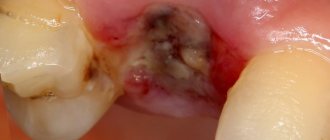Symptoms of a tooth abscess
The inflammatory process in the tissues of the tooth and gums occurs in stages and is accompanied by different symptoms:
- At the beginning of development, discomfort appears, slight swelling, gum bleeding is possible when brushing teeth, and pain is sensitive when pressed.
- In later stages, swelling increases, and a reaction to hot and cold foods appears. There is prolonged pain and an unpleasant odor. In addition to local changes, the abscess is accompanied by enlarged lymph nodes in the neck, increased body temperature, and general malaise.
A bitter aftertaste is noticeable in the mouth, and a change in the shade of the tooth body is possible. It is important to remember: the symptoms of gum abscess can manifest themselves in different ways - everyone has their own pain sensitivity threshold and perceives signals subjectively. Therefore, you should not wait for acute conditions; a reasonable step is to visit a dental clinic at the first incomprehensible sensation.
Sepsis. Septic shock
Introduction
Just as local immunity reacts to a splinter - with a rush of blood, a local increase in temperature, activation of immune factors, and an attack of macrophages on bacteria brought in with dirt - general immunity tries to cope with the pathogenic microorganism and its toxins if they penetrate the systemic bloodstream and spread throughout all tissues and organs.
In this case, an acute infectious-inflammatory process flares up on the scale of the entire organism, and, figuratively speaking, something like a total atomic war begins, where the enemy can be destroyed only at the cost of self-destruction. According to rough WHO estimates, sepsis affects over 30 million people every year, of whom at least one in five die from this cause. The epidemiological situation is especially unfavorable in underdeveloped regions, but in much more prosperous countries there is sepsis, including iatrogenic, i.e. associated with the provision of medical care remains a formidable and pressing problem, especially considering that the cause is often hospital microflora, habitual and resistant to almost any antibiotics.
There are many terminological definitions of the concept of “sepsis”. Previously, the presence of a pathogenic organism in the circulatory system was indicated as an obligate, obligatory sign, then the “systemic inflammatory reaction” (septicemia) was emphasized. Recently, however, in medicine there has been a desire for more and more precise formulations and a clear delineation of concepts. It was found, for example, that not every bacteremia (the presence of bacteria in the blood) leads to sepsis, and vice versa: a condition that is extremely close in essence and clinically to septic shock can develop in the absence of bacteremia (see the material “Infectious-toxic shock” ). Today, many theoretical and methodological positions have been revised; In 2016, new guidelines on sepsis were presented by the Society of Intensive Care Medicine (SCCM) and the European Society of Intensive Care Medicine (ESICM). The definition of the concept no longer focuses on a “systemic reaction to infection,” but on life-threatening multiple organ dysfunction due to impaired regulation of the immune response (such a regulatory disorder can be compared, again, with the order “Beat everyone, your own and others, with whatever you like, as it turns out.” by any force"). The concept of “severe sepsis” has been excluded from the guidelines as unnecessary and tautological. And then to say: if this is really sepsis, the situation is in any case quite serious.
Also in 2016, a study was conducted in the United States on the cost of medical care provided in an intensive short-term mode. Among the conditions requiring the most expensive emergency response, sepsis was in first place (osteoarthritis in second, perinatal pathology in third, implantation complications in fourth, myocardial infarction in fifth).
In 2022 , it was proven that the introduction of new intensive care protocols for sepsis significantly reduces mortality. However, it remains high and is estimated at 20-35%, and in septic shock (the most severe, extreme form of sepsis) varies in the range of 30-70%.
Since 2008, in St. Petersburg, the country’s only Center for the treatment of severe sepsis has been operating at the Research Institute of Emergency Medicine named after. Dzhanelidze. Its director, Professor S.A. Shlyapnikov, repeatedly drew the attention of the medical community to the fact that domestic sepsis statistics do not fully reflect reality; that this diagnosis, especially if it is established posthumously as a postoperative diagnosis, is very disliked “at the top”; that in fact, almost all patients who die after complex surgical interventions on the third or fourth day die precisely from sepsis, and not from the “main diagnosis.”
Since 2015, the multidisciplinary Society of Sepsis Specialists has been actively working in St. Petersburg.
September 13 is World Sepsis Day.
In August 2022, under the auspices of the Global Alliance against Sepsis, the Second World Congress on Sepsis was held, and it was held entirely online, thereby uniting and connecting interested specialists from various countries. All this suggests that even today, in the era of asepsis and antiseptics, the problem of “blood poisoning” has not disappeared.
What complications can there be?
Even if the pain has dulled, the symptoms have become less pronounced, you should not postpone your visit to the dentist. This situation may be a signal indicating the death of the root and the further spread of infection to the organs of the head or neck.
The area cannot be heated. This approach will bring short-term relief, but will accelerate the formation of the fistula and stimulate the release of pus.
Possible serious complications: brain inflammation, pneumonia. There is a risk of sepsis, development of osteomyelitis, damage to the nasal sinuses or meninges.
Flux (periostitis)
Another common complication of pulpitis is inflammation of the periosteum. This is the periosteum, a fibrous membrane covering bone tissue. Flux develops in the projection of the lesion on the gum side. Pus accumulates under the mucous membrane and an abscess forms. In this case, a fistula may appear on the gum.
A characteristic symptom of gumboil is swelling of the gums and soft tissues of the face on the side of the affected tooth. The patient complains of severe pain. As a rule, body temperature rises.
Treatment of pulpitis of a baby tooth
2280 rub.
Tooth restoration after pulpitis/periodontitis
from 3490 rub.
Treatment of tooth pulpitis
from 5060 rub. up to 9880 rub.
Causes of dental inflammation
The main causes of tooth gum abscess and pulp infection:
- Advanced caries affecting the root apex. Suppuration develops against the background of periodontitis.
- Untreated gingivitis and periodontitis (gum disease). They often develop as post-traumatic complications: pathogenic microflora accumulates in periodontal pockets.
- Weakening of the immune system after illness (flu, sore throat, etc.).
- Iatrogenic factors - bacteria entered after the use of unsterile instruments during treatment, injections, or incorrect tooth extraction.
The development of the inflammatory process may be preceded by damage to the oral mucosa and the formation of boils.
How to treat an abscess
A specialist can easily diagnose a dental abscess. To do this, he needs to examine the patient. The doctor may also prescribe an x-ray in order to exclude medical error when making a diagnosis.
The main goal of treating an abscess is to eliminate the infection by specialists; at the same time, you need to be able to save your teeth and eliminate complications.
Doctors often use drainage of the abscess. To do this, a procedure such as tooth root canal is performed. Dead parts of the damaged tooth root are also removed. Next, the tooth is filled and, if necessary, a crown is placed. Drainage can be done by making an incision in the swollen gum if a tooth has been removed.
If an infection has developed and saving the tooth is problematic, the doctor will remove it.
Sometimes a modern treatment method is used, namely low-intensity laser. This laser allows you to open an abscess and drain it with less pain.
Also, specialists may prescribe a course of antibiotics and rinsing to reduce pain and discomfort.
Prevention
Methods for preventing abscess are simple. They include maintaining oral hygiene, timely treatment of diseases, periodic visits to the dentist, and avoiding any injuries to the mouth.
A disease such as a tooth abscess should not be ignored. If you have the slightest suspicion of an abscess, you should not delay it and you should immediately contact a dental clinic.
Number of views 3,678
Bacteria
Next, bacteria are introduced into the already weakened cells, which are able to completely destroy the cell, feeding on its insides. According to the nature of their development, they are divided into those that are able to divide and grow only inside the cell (chlamydia, etc.) and those that multiply both inside and outside the cell (mycoplasma, legionella, listeria, rickettsia, etc.). The variety of lesions they cause is explained by their sensitivity to different types of host cells (human, animal).
Intracellular bacteria:
Chlamydia:
- chlamydia trichomatis (trachoma, urogenital chlamydia and pneumonia of newborns, lymphogranuloma venereum, arthritis, arthrosis, heart damage)
- chlamydia from birds (ornithosis - pneumonia, fever)
- chlamydia pneumoniae (pneumonia, acute respiratory infections, atherosclerosis, bronchial asthma)
Rickettsia:
- rickettsia (rickettsiosis, typhus)
- rohalimia (trench fever, cat scratch disease)
- Klebsiella (Congo red fever)
Escherechia:
- Escherechia (maculopapular rash)
- bartonella (bartonellosis)
By multiplying in cells, intracellular bacteria are protected not only from various influences from the human body, but also from the effects of most antibacterial drugs that are not able to penetrate inside cells. Extracellular bacteria feed on already decomposed cells, “melting” them and turning them into pus. They are a kind of orderlies (cleaners) of the body, cleaning out diseased organs and systems.
Extracellular bacteria:
- Staphylococcus (skin pustular infections, endocarditis, pneumonia, arthritis, osteomyelitis, peritonitis, eye infections, toxic shock syndrome, food toxic infections)
- Oral sticks (gingivitis, stomatitis, endocarditis, sepsis)
- Streptococci (pharyngitis, postpartum infections, neonatal sepsis, bacteremia, meningitis, arthritis, genitourinary tract infections, pneumonia, sinusitis, otitis of the middle ear, rheumatic attack, abscesses of the lungs, liver, brain)
- Bacilli (Anthrax, bacteremia, septicemia, meningitis, eye infections, pneumonia, endocarditis, food poisoning
- Corynebacteria (diphtheria, erythrasma, skin lesions in the axillary and groin area, cellulitis, septicemia, brain abscesses and osteomyelitis)
- Clostridia (gas gangrene, foodborne illnesses, necrotic enteritis, tetanus, botulism)
- Gonorrheal bacillus (infections of the lower parts of the genitourinary tract (cervicitis, urethritis, abscesses of the glands adjacent to the vagina), infections of the upper parts of the genitourinary tract (endometritis, epididymitis, pelvic inflammatory diseases), infections of other organs and tissues (proctitis, pharyngitis, blenorrhea, pelvic peritonitis and perihepatitis, pharyngeal gonorrhea), disseminated gonococcal infection; meningococcal infection)
- Pseudomonas (skin lesions, abscesses, infection of burn lesions, keratitis, conjunctivitis, otitis of the external ear, meningitis, bacteremia, endocarditis, enteritis, para- and rectal abscesses, pneumonia, urinary tract infections, osteomyelitis and arthritis)
- Flavobacteria (colonize wounded surfaces, respiratory, intestinal tracts, organs of the genitourinary system, severe meningitis of newborns, septicemia, endocarditis, pneumonia).
Intracellular and extracellular bacteria not only get along with each other, but, participating in the cycle, eat what the previous microorganisms destroyed. They can be compared to jackals and hyenas, eating what is left of the victim after a tiger.
Causes and symptoms of oral sepsis
The cause of oral sepsis can be the above microorganisms: staphylococcus, E. coli and streptococcus, as well as toxins and breakdown products of certain tissue proteins.
This type of sepsis usually begins in the tonsil area and results from periodontal disease.
Oral sepsis has the same symptoms as any other type of sepsis. For example, symptoms may include the following:
- very rapid fatigue of the body and the feeling that a person cannot get enough sleep;
- general weakness and constant headache;
- leukocytosis and lymphocytosis;
- unusual body temperature for a person - too high or, conversely, too low;
- increase in ESR;
- small inflammatory areas, a test of which indicates the presence of sepsis.
Sepsis is a disease that can last only a few hours, however, in some cases, this type of disease can last for several days, months and even years. Oral sepsis is precisely the form of the disease that lasts for quite a long period, and that is why doctors in St. Petersburg often call it chronic.
Phlegmon
Untreated periostitis can, in turn, be complicated by acute infection of the subcutaneous fatty tissue. In this case, phlegmon develops. Symptoms of this disease:
- Severe swelling on one side of the face, neck, cheekbones.
- Difficulty opening the mouth, painful chewing and swallowing food.
- Severe pain syndrome.
- Bad breath.
- Temperature rise to 39-41 °C;
- A burning sensation in the area of localization of inflammation.
Cellulitis can develop very quickly, so if possible signs appear, you should consult a doctor immediately.
Clinical classification of sepsis by stages
Clinical staging of sepsis plays an important role, as it helps doctors choose the optimal tactics and achieve the best possible treatment results in each specific case. The following stages are distinguished:
- Sepsis is diagnosed when the core temperature (measured on the mucous membranes) of the body rises above 38 degrees or falls below 36 degrees, heart rate 90 bpm or more, respiratory rate 20 bpm or more, or partial pressure of carbon dioxide in arterial blood (PaCO2 ) falls below 32 mm. Hg Art. In this case, the level of leukocytes in the blood rises to more than 12,000/μl or falls below ≤4000/μl, or more than 10% of immature forms appear among them.
- Severe sepsis is sepsis that is combined with acute organ dysfunction.
- Septic shock is diagnosed when a patient has persistent hypoperfusion (low blood pressure) or tissue hypoperfusion (insufficient blood supply) despite adequate fluid resuscitation.
- Multiple organ dysfunction syndrome is a condition in which the patient has organ dysfunction (impaired functioning of internal organs), and its homeostasis cannot be maintained without drug intervention.
1.What is sepsis?
Sepsis
is a serious disease caused by a suppressed immune response to infection. The more commonly known common name for sepsis is blood poisoning. To fight infection, the body produces chemicals that can cause severe inflammation throughout the body. This inflammation can in turn lead to organ damage.
Blood clotting in sepsis reduces blood flow to the limbs and internal organs, depriving them of nutrients and oxygen. In particularly severe cases, the infection leads to a life-threatening drop in blood pressure. This condition is called septic shock
, and it is really very serious. Septic shock can quickly lead to multiple organ failure—the lungs, kidneys, and liver—causing death.
A must read! Help with treatment and hospitalization!
Osteomyelitis of the jaw
One of the very serious complications of advanced pulpitis is the penetration of infection not only into the periodontium, but also into the bone tissue of the jaw. At the same time, destructive processes develop in it, which are clearly visible on an x-ray.
Often the cause of the development of osteomyelitis is difficult-to-erupt wisdom teeth. This disease is characterized not only by local symptoms, but also by signs of poisoning of the body, such as headache, weakness, poor sleep, and fever.











